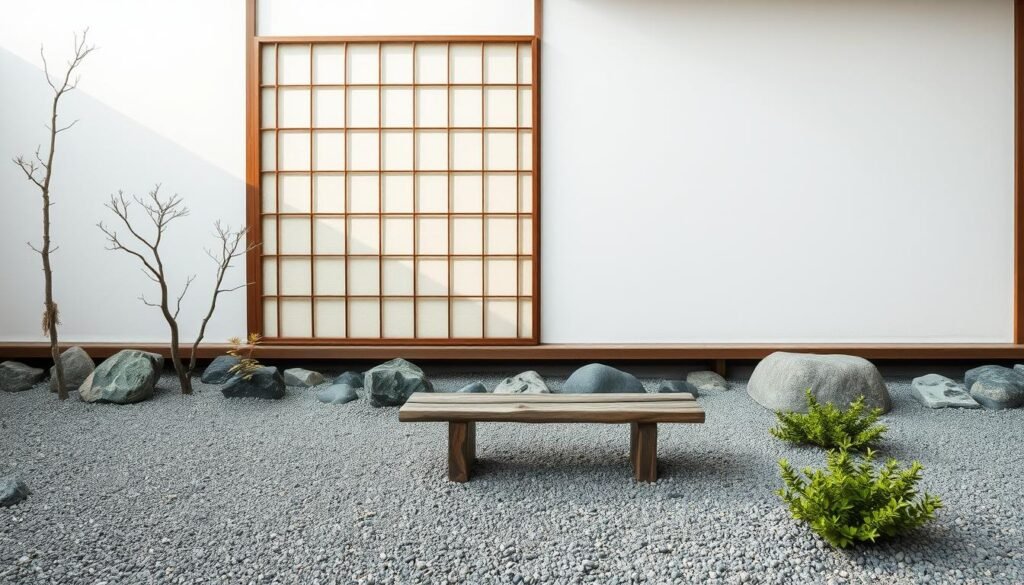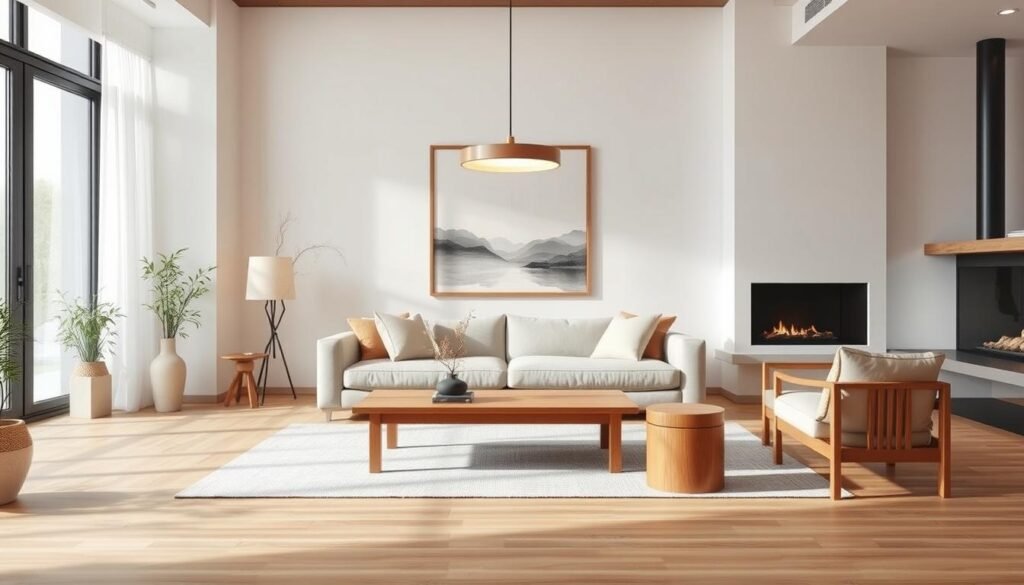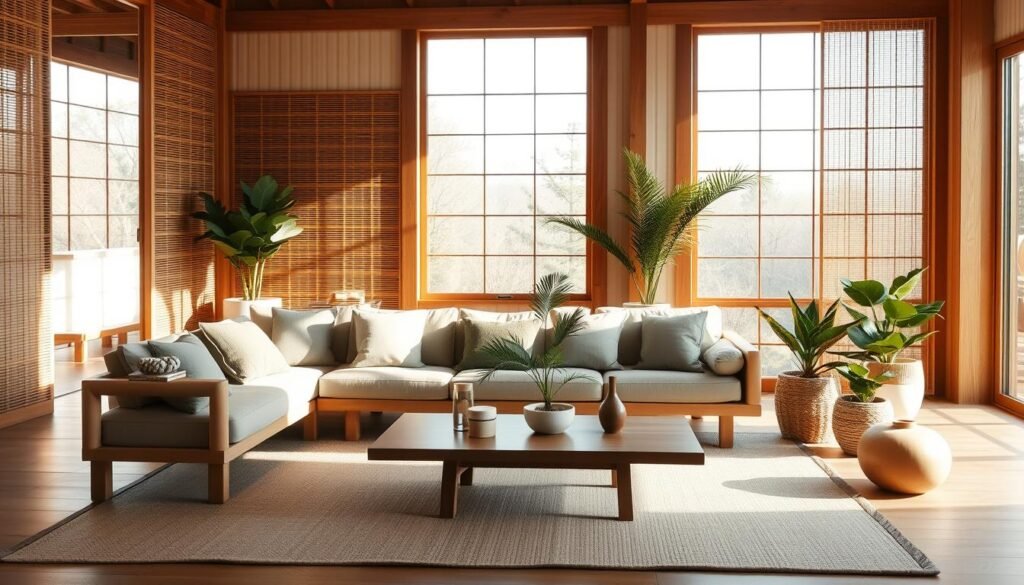This post may contain affiliate links. When you purchase through links on our site, we may earn an affiliate commission.
Did you know homes embracing this cross-cultural design philosophy report 47% higher satisfaction with their living spaces compared to traditional interiors? My journey began when I realized how cluttered environments drained my energy. That’s when I discovered a movement reshaping modern homes—one that merges clean lines with soulful warmth.
What started as curiosity became a revelation. This approach isn’t just about furniture placement—it’s a mindset prioritizing intentionality in every detail. By combining Nordic functionality with Eastern reverence for nature, I created spaces that breathe rather than confine.
The magic lies in balance. Light wood tones meet textured neutrals, while sleek forms coexist with organic shapes. Each room now serves as a sanctuary, proving minimalism doesn’t require sacrificing comfort. My kitchen countertops showcase smooth concrete beside handcrafted ceramics—proof that practicality and artistry aren’t mutually exclusive.
Key Takeaways
- Fuses Nordic functionality with Japanese reverence for natural materials
- Creates balance between visual simplicity and tactile warmth
- Transforms living areas into mindful retreats rather than showrooms
- Prioritizes quality craftsmanship over disposable decor trends
- Encourages intentionality in both design choices and daily habits
Through trial and error, I’ve learned this philosophy extends beyond surfaces. It’s about cultivating spaces that evolve with you—where every object has purpose and every corner sparks joy. The result? A home that doesn’t just look curated but feels authentically yours.
Introduction to Japandi: A Harmonious Fusion
What happens when Nordic practicality dances with Eastern mindfulness? You get spaces where form follows feeling. This cross-cultural approach reshapes how we experience rooms—not just decorate them.
https://www.youtube.com/watch?v=c14k5leN14k
Defining the Japandi Aesthetic
I discovered its magic through texture contrasts. Smooth oak floors underfoot, rough linen cushions in hand. Unlike stark minimalism, this fusion celebrates imperfect beauty. Finnish architect Alvar Aalto once said:
“Beauty is the harmony of function and form.”
That’s Japandi in essence—utilitarian poetry.
Origins and Influences
Mid-century creators planted the seeds. Danish designer Finn Juhl blended Shinto-inspired simplicity with Nordic craftsmanship. Their work revealed shared values: natural materials, clean lines, mindful living. Both cultures cherish light—Scandinavians through airy spaces, Japanese through subtle shadow play.
| Style | Materials | Philosophy | Japandi Fusion |
|---|---|---|---|
| Japanese | Bamboo, washi paper | Wabi-sabi (imperfection) | Organic textures |
| Scandinavian | Pale wood, wool | Hygge (coziness) | Functional warmth |
| Shared Elements | Neutral palettes, handcrafted details, connection to nature | ||
This blend solves design dilemmas. Nordic elements soften Japanese austerity, while Eastern warmth counters Scandinavian coolness. My favorite discovery? How tatami mat patterns inspired Danish parquet layouts—proof that great styles speak the same language.
Exploring the Philosophy Behind Japandi
True harmony in living spaces begins when every object has intention. This philosophy merges Japan’s wabi-sabi appreciation for weathered beauty with Scandinavia’s hygge focus on comforting rituals. What emerges isn’t just decor—it’s a roadmap for living mindfully.

Embracing Minimalism and Functionality
I learned through danshari—the art of selective keeping—that clutter-free doesn’t mean sterile. My coffee table now holds only three meaningful items: a hand-turned wooden bowl, a single art book, and a candle for evening reflection. Each serves daily needs while sparking joy.
This approach transformed how I view storage. Closed cabinets hide necessities, while open shelves display purposeful beauty. A linen-wrapped bench doubles as shoe storage and seating—proof that practicality can be poetic.
The Balance of Warmth and Simplicity
Early attempts at minimalism left rooms feeling cold. The solution? Layering textures like nubby wool throws over smooth concrete floors. I discovered imperfect symmetry—matching ceramic lamps flanking an asymmetrical driftwood centerpiece.
Lighting plays a crucial role. Paper lanterns diffuse glow upward, while Danish pendant lights cast downward pools of warmth. Together, they create dynamic balance—bright enough for tasks, soft enough for relaxation.
Adopt the Japandi style, blending Scandinavian and Japanese aesthetics
The moment I stepped into my clutter-free living room, I knew I’d found my design truth. What began as an experiment in restraint became a revelation about how spaces shape our daily experiences.

My Personal Journey to Japandi Living
Three years ago, my home felt like a storage unit. The breakthrough came during a rainy afternoon spent sorting through inherited china. I realized true comfort comes from curated emptiness, not filled shelves. That’s when I discovered a design philosophy valuing both airiness and earthy textures.
My first change involved paint. I replaced bold accent walls with soft greige tones, instantly calming the space. Next came furniture swaps—out went bulky sectionals, in came a slender oak bench with linen cushions. Each choice taught me that empty surfaces breathe life into rooms.
Incorporating Core Design Principles
These three rules guided my transformation:
- Natural materials dictate selections (wood grain becomes the decoration)
- Every item must serve practical or emotional needs
- Color exists in whispers—moss-green throws, slate-blue ceramics
I learned to love negative space. Where I once displayed collections, now a single bonsai commands attention. My coffee table? Smooth birch with visible knots, paired with a stoneware vase holding seasonal branches. This approach turned my apartment into a functional meditation space that adapts to my moods.
Surprisingly, minimalism amplified comfort. Fewer objects mean better quality choices. A wool rug feels luxurious underfoot precisely because it’s the only textile in the room. Through this process, I discovered design isn’t about filling spaces—it’s about creating room to live fully.
Designing Harmonious Spaces with Japandi Elements
My living room transformation taught me spaces become sanctuaries when elements collaborate rather than compete. Through intentional layering, I discovered how curated emptiness amplifies both functionality and serenity.

Creating Functional, Decluttered Interiors
I start every redesign by asking: “What does this area need to do?” My entryway solution? A slim oak bench with hidden shoe storage beneath linen cushions. Closed cabinets store essentials, while open shelves display only what sparks joy—like hand-thrown pottery holding daily keys.
Vertical space became my ally. Hanging planters add greenery without sacrificing surface areas. A woven basket corrals blankets yet adds texture. This approach maintains breathing room while keeping necessities within reach.
Mixing Modern Minimalism with Natural Warmth
The secret lies in tactile contrasts. Smooth concrete countertops gain life from rough-hewn wooden bowls. I introduced a trailing pothos plant above my workspace—its organic shape softens clean-lined shelving.
Lighting layers create mood magic. Paper lanterns cast soft glows alongside matte-black task lamps. My favorite fusion? A chunky knit throw draped over sleek teak dining chairs. These combinations prove simplicity doesn’t mean starkness.
Through trial, I learned harmony thrives in purposeful pairings. A ceramic vase holding cooking utensils becomes art. Bamboo blinds filter light while adding vertical rhythm. Every choice whispers: “This belongs here.” The result? Interiors that calm chaos without feeling sterile.
Materials, Color Palettes, and Textural Contrasts
I discovered materials speak louder than decor trends when creating cohesive spaces. My kitchen redesign revealed how raw elements shape atmosphere—rough stone surfaces whispering earth’s stories beside smooth ceramics echoing human touch.
Using Natural Materials Like Wood and Linen
Light ashwood became my foundation. Its grain patterns guide the eye without shouting. Paired with undyed linen curtains, these natural materials filter sunlight into honeyed glows. Bamboo drawer pulls add organic rhythm, their subtle ridges inviting tactile exploration.
Stone accents ground the palette. A slate coaster cradles my morning mug, its cool surface contrasting warm wood tones. Ceramic vases hold dried botanicals—textures conversing across surfaces. These choices remind me daily: nature designs best.
Neutral Tones and Muted Accents for Serene Look
My color strategy? Let materials shine. Walls wear soft putty tones, becoming backdrops for wood’s caramel hues. Textured throw pillows in oat and moss colors add depth without visual noise.
Surprise comes through material contrasts. A polished concrete lamp base meets its match in nubby wool shade. These pairings prove neutral doesn’t mean flat—when textures dance, monochrome palettes sing.

 using WordPress and
using WordPress and 
No responses yet